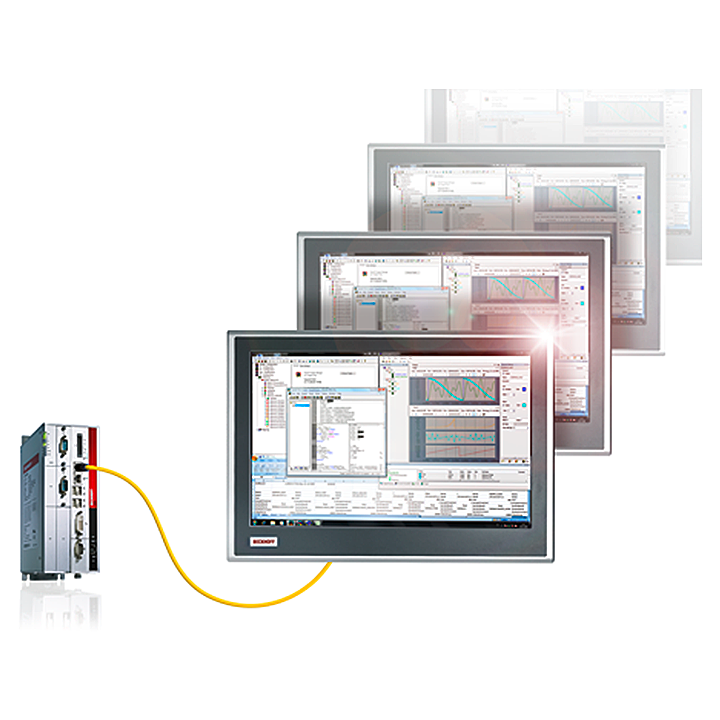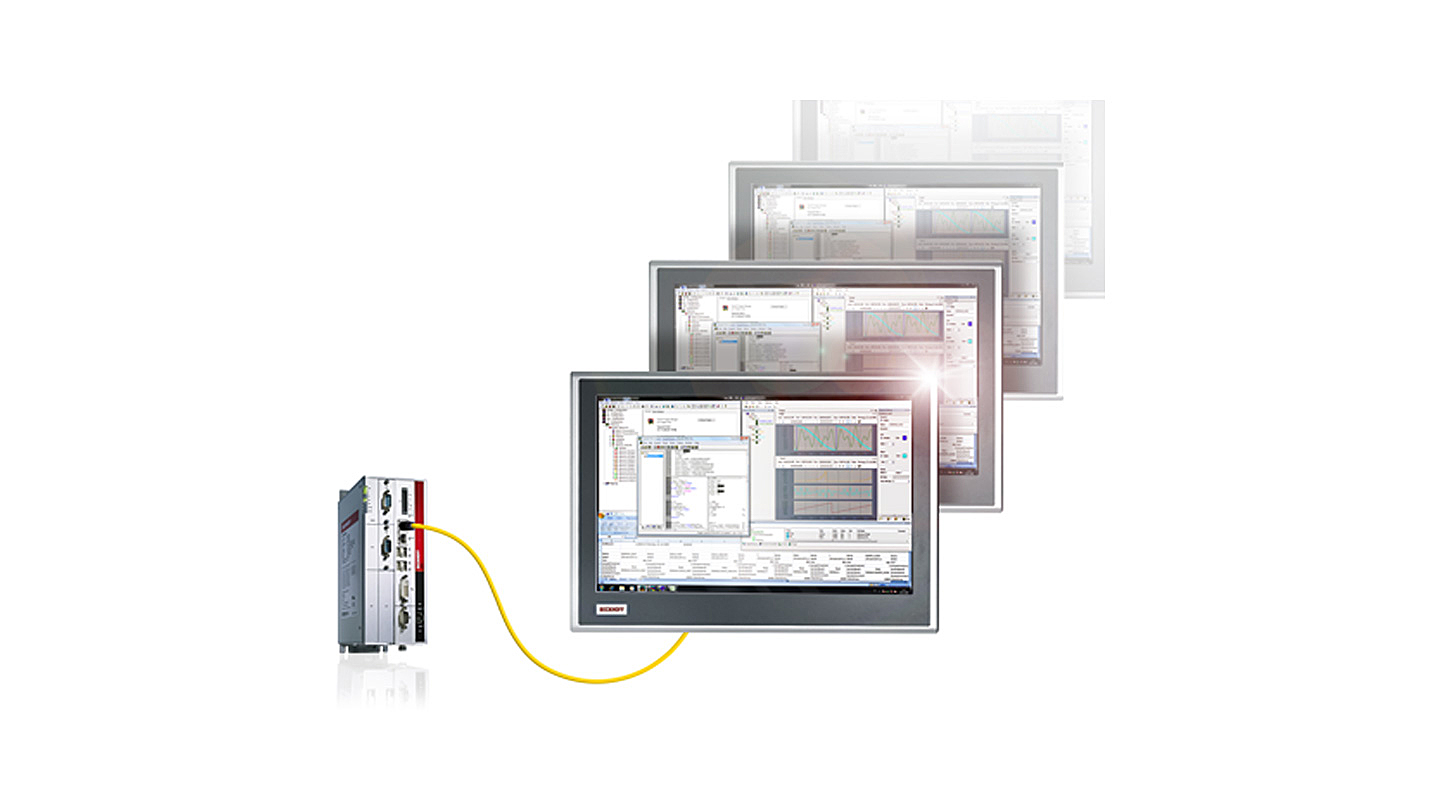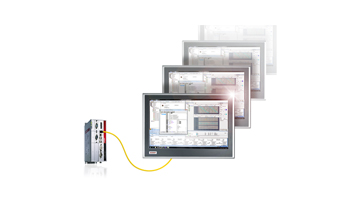
CP‑Link 3 transfers the desktop of a PC via Ethernet to several Panel PCs and the operator mouse and keyboard entries to the host PC. The screen contents are captured by a virtual graphic adapter in the host PC and sent using Ethernet to one or more Panel PCs with Windows operating systems (CE, XP Windows 7 or Windows Embedded Standard). Networking can be done using cost-effective standard Ethernet cables (CAT 5) which are suitable for drag chains.
Since the data and image transfer are based on TCP/IP, the operating and display functions can be extended using the Internet. Panel PCs can be integrated using the Internet via VPN (Virtual Private Network). A VPN service must be available for the Internet security functions.
Keyboard entries, touch screen and special key functions are transferred from the client to the host PC via Virtual USB. USB devices connected to a Panel PC appear in the host PC like locally plugged-in devices and can be used in the normal way.
Virtual USB emulates a USB root hub in the host PC. If a USB device is plugged into a Panel PC, then the virtual hub logs the device on to the operating system of the host PC and transparently transmits the ensuing communication. For the operating system, the USB device behaves as though it was directly connected to the PC. Virtual USB transfers the standards USB 1.1 and USB 2.0. As communication takes place using 100 Mbit/s Ethernet, the USB 2.0 transmission performance (480 Mbit/s) is restricted.
Additional input/output devices on the Panel PCs, such as rotary switches, buttons, etc., are read in by the host PC using an additional communication channel. Printers and webcams, which are connected to a Panel PC by means of USB, can be used from the host PC.
The scope of delivery for CP‑Link 3 includes host and client software. The host PC may have Windows XP, Windows 7 or Windows Embedded Standard installed. Panel PCs with Windows CE, Windows XP, Windows 7 or Windows Embedded Standard are used as clients. As the application software (PLC/NC, HMI, etc.), once started, runs on the host PC, any necessary software licenses are only payable once for the host PC. The client Panel PCs only receive image data. Apart from the operating system and CP‑Link 3, no other software license is required for the clients. Even for PCs with more than one graphics card only one license per application software is required. For host PCs of other vendors an upgrade license is required..
Single Desktop
A Panel PC is connected with a host PC via Ethernet and shows the image of the host PC. Communication takes place using TCP/IP.
Keyboard entries, touch screen and special key functions are transferred from the client to the host PC via Virtual USB. USB devices connected to a Panel PC appear in the host PC just like locally connected devices.
- Ethernet and IP protocol-based desktop transfer software CP-Link 3
- transfers the desktop of a PC via Ethernet to one Panel PC
- transmission of mouse and keyboard inputs of the client user to the host PC
- connection by Ethernet or Internet, TCP/IP
- 1 virtual graphic adapter
- Virtual USB
- USB devices connected at the client are found by the host PC like a local USB device.
- 1 client controllable
- The client shows the screen of the host PC.
- host software for PCs with Windows XP, Windows 7 or Windows Embedded Standard
- client software for Beckhoff Panel PCs with Windows CE, Windows XP, Windows 7 or Windows Embedded Standard
Multi Desktop
Several Panel PCs are connected with a PC via Ethernet and display the image of the host PC. All connected client Panel PCs show the same image.
Communication takes place using TCP/IP (up to 10 Panel PCs) or via UDP Multicast (up to 255 Panel PCs). The benefit of Multicast lies in the fact that messages can be transferred to several Panel PCs simultaneously without the transmitter bandwidth multiplying by the number of receivers.
- Ethernet and IP protocol-based desktop transfer software CP-Link 3
- transfers the desktop of a PC via Ethernet to Panel PCs
- transmission of mouse and keyboard inputs of client users to the host PC
- connection by Ethernet or Internet, TCP/IP or UDP/IP (Multicast)
- 1 virtual graphic adapter
- Virtual USB
- USB devices connected at a client are found by the host PC like a local USB device.
- Up to 255 clients are controllable in UDP/IP mode, up to 10 clients in TCP/IP mode.
- All clients show the same picture, the screen of the host PC.
- The input devices can be locked at any client by TwinCAT PLC or via application programming interface (API)
- host software for PCs with Windows XP, Windows 7 or Windows Embedded Standard
- client software for Beckhoff Panel PCs with Windows CE, Windows XP, Windows 7 or Windows Embedded Standard
Extended Desktop
One or several virtual graphic adapters are used to extend the host PC desktop. The program windows of the application software can be moved to additional monitors covered by the extended desktop. Applications may be started on a specific monitor. The desktop can be extended to up to 9 monitors. CP-Link 3 can transfer the data via Ethernet to several client Panel PCs.
The mouse and keyboard entries of individual clients can be locked via TwinCAT PLC or a software interface (API), in order to prevent interference between several users.
- Ethernet and IP protocol-based desktop transfer software CP-Link 3
- transfers up to 9 screens of the extended desktop of a PC via Ethernet to Panel PCs
- transmission of mouse and keyboard inputs of client users to the host PC
- connection via Ethernet or Internet, TCP/IP or UDP/IP (Multicast)
- Up to 9 virtual graphic adapters extend the desktop of the host PC.
- Virtual USB
- USB devices connected at a client are found by the host PC like a local USB device.
- Up to 255 clients are controllable in UDP/IP mode, up to 10 clients in TCP/IP mode.
- Each client shows 1 of maximally 9 screens of the extended desktop of the host PC.
- The input devices can be locked at any client by TwinCAT PLC or via application programming interface (API).
- Applications are allocable to one of the additional screens of the extended desktop.
- host software for PCs with Windows XP, Windows 7 or Windows Embedded Standard
- client software for Beckhoff Panel PCs with Windows CE, Windows XP, Windows 7 or Windows Embedded Standard
Product status:
service phase | Possibly with other technical features or equipment in case of a service order or repair
© Beckhoff Automation 2025 - Terms of Use

